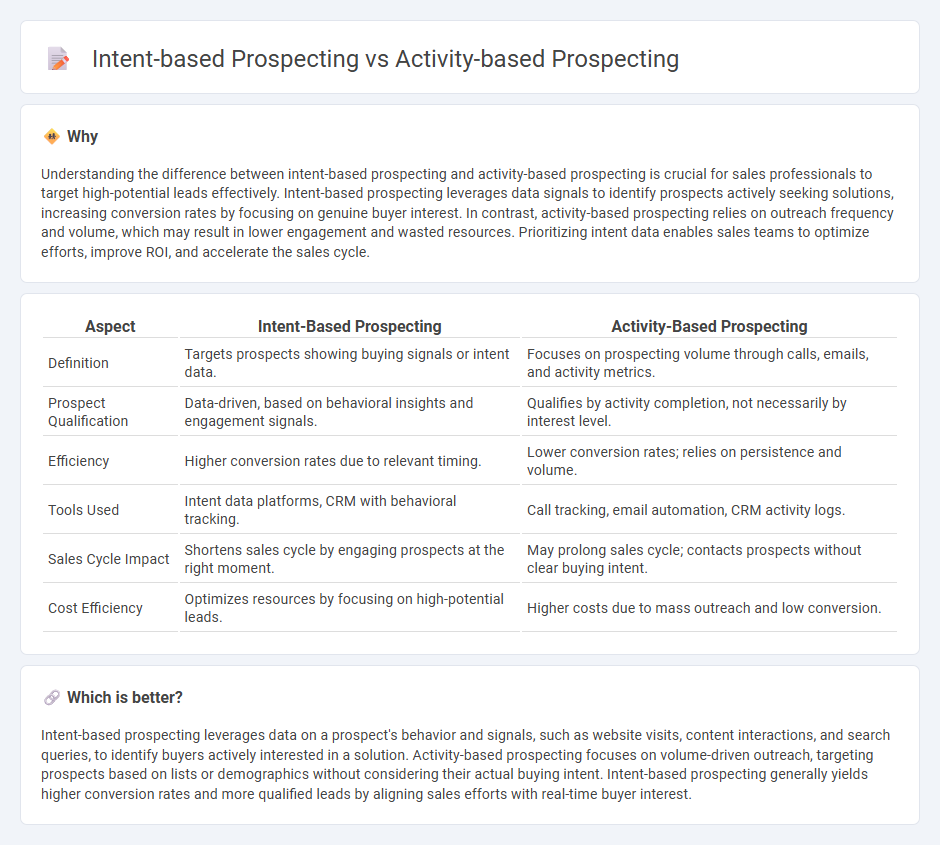
Intent-based prospecting leverages real-time data and behavioral signals to identify potential customers showing active interest in products or services, increasing the likelihood of successful engagement. Activity-based prospecting relies on volume-driven outreach methods, such as cold calling and mass emails, often resulting in lower conversion rates due to lack of personalized targeting. Explore how integrating intent signals can transform your sales strategy and boost conversion efficiency.
Why it is important
Understanding the difference between intent-based prospecting and activity-based prospecting is crucial for sales professionals to target high-potential leads effectively. Intent-based prospecting leverages data signals to identify prospects actively seeking solutions, increasing conversion rates by focusing on genuine buyer interest. In contrast, activity-based prospecting relies on outreach frequency and volume, which may result in lower engagement and wasted resources. Prioritizing intent data enables sales teams to optimize efforts, improve ROI, and accelerate the sales cycle.
Comparison Table
| Aspect | Intent-Based Prospecting | Activity-Based Prospecting |
|---|---|---|
| Definition | Targets prospects showing buying signals or intent data. | Focuses on prospecting volume through calls, emails, and activity metrics. |
| Prospect Qualification | Data-driven, based on behavioral insights and engagement signals. | Qualifies by activity completion, not necessarily by interest level. |
| Efficiency | Higher conversion rates due to relevant timing. | Lower conversion rates; relies on persistence and volume. |
| Tools Used | Intent data platforms, CRM with behavioral tracking. | Call tracking, email automation, CRM activity logs. |
| Sales Cycle Impact | Shortens sales cycle by engaging prospects at the right moment. | May prolong sales cycle; contacts prospects without clear buying intent. |
| Cost Efficiency | Optimizes resources by focusing on high-potential leads. | Higher costs due to mass outreach and low conversion. |
Which is better?
Intent-based prospecting leverages data on a prospect's behavior and signals, such as website visits, content interactions, and search queries, to identify buyers actively interested in a solution. Activity-based prospecting focuses on volume-driven outreach, targeting prospects based on lists or demographics without considering their actual buying intent. Intent-based prospecting generally yields higher conversion rates and more qualified leads by aligning sales efforts with real-time buyer interest.
Connection
Intent-based prospecting leverages data on potential customers' online behavior and signals to identify high-interest leads, while activity-based prospecting focuses on tracking specific actions and engagement levels to qualify prospects. Both methods utilize customer insights and behavioral data to enhance targeting accuracy and improve conversion rates by aligning sales efforts with buyer readiness. Integrating these approaches allows sales teams to prioritize prospects more effectively, combining intent signals with measurable activities for optimized pipeline development.
Key Terms
Outreach Cadence
Activity-based prospecting emphasizes consistent outreach cadence through scheduled calls and emails to maximize touchpoints and maintain steady engagement flow. Intent-based prospecting relies on triggers from prospect behavior data, such as website visits or content downloads, to time outreach for higher relevance and conversion potential. Explore comprehensive strategies to optimize your outreach cadence for better sales performance.
Buyer Signals
Activity-based prospecting targets prospects based on their actions, such as website visits or content downloads, prioritizing engagement metrics to identify potential buyers. Intent-based prospecting leverages buyer signals like search queries, content consumption patterns, and purchase intent data, enabling more precise targeting of prospects actively researching solutions. Discover how integrating buyer signals can enhance your prospecting strategy.
Lead Qualification
Activity-based prospecting measures lead qualification through actions such as email opens, clicks, and calls, emphasizing quantity and consistent outreach. Intent-based prospecting relies on behavioral indicators like content consumption, search queries, and engagement signals to identify high-quality leads showing active interest. Explore deeper insights on optimizing lead qualification by comparing these prospecting strategies.
Source and External Links
How to Implement an Activity-Based Selling - noCRM.io - Activity-based prospecting involves setting specific activity targets for salespeople (such as calls or meetings) instead of revenue goals, which guides their daily efforts to achieve sales objectives through measurable actions like qualifying leads and contacting prospects.
Activity Based Selling: The Best Technique To Reach Your Business Goals - This sales method translates revenue targets into concrete, short-term activities such as making cold calls or sending emails, providing sales teams with clear, achievable actions that naturally lead to reaching overall sales goals.
The Ultimate Guide to Activity-Based Selling - Pipedrive - Activity-based prospecting is part of activity-based selling that helps salespeople focus on proactive, measurable steps focused on engaging prospects continuously, thereby increasing pipeline deals and accelerating closing rates through well-planned daily sales actions.
 dowidth.com
dowidth.com